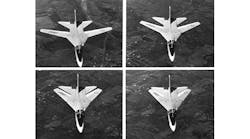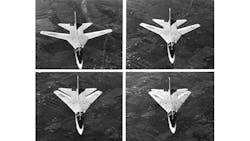Any kind of engineering project can require some detective work. The thing doesn’t work; you ask yourself, “How come?” and you start detecting. Sometimes, the detecting rises above mere troubleshooting. You have to dig into human nature itself to ferret out the problem. I’ve been close to a few of those (though as a bystander, rather than sleuth) in the 50 years since I got my EE.
Backwards Human-Factors
The first, I learned about from some of my RPI grad-school friends who went to work at the Air Force Flight Test Center (FTC) at Edwards Air Force Base, while I went to work for an aviation subcontractor in L.A.
In January 1967, during flight-testing for the F-111 fighter, a prototype crashed on approach to a landing. In this case, the engineering detection turned up an unexpected human-factors glitch.
The F-111 was the first jet fighter to have wings that swept back for high-speed flight and swept forward for low-speed loitering or for landing. (See the figure above, or watch a video here.)
Originally, the control was a lever adjacent to the throttle the pilot pushed forward to sweep the wings forward and pulled back to sweep the wings back. The wings followed the lever; it was perfectly simple. Simple human-factors engineering.
What the engineers at the FTC quickly deduced was that it was simple for everybody but trained fighter test pilots. From the earliest days of aviation, a pilot pulls controls backward to go slow for touchdown: stick and throttle, for sure, and for old piston aircraft, mixture and prop pitch as well. By the time someone’s a test pilot, that’s as natural as breathing. But pulling back, and causing the wings to sweep back to the position they’re in for supersonic flight is exactly the last thing you want to do on final approach to the runway. Your source of lift disappears before you reach your intended touchdown point.
Actually, this was a case in which detecting the problem was less challenging than coming up with a solution. What the engineers at General Dynamics came up with was a sort of hybrid control: a pilot would push it forward to go fast, pull it back to maintain lift when landing, but, instead of being just a dumb lever, it was geared with little movable wings that emulated what the wings on the plane were doing.
Watch Those Maintenance Guys!
I didn’t have anything to do with the Flight Test Center except talking with my friends who worked there (about things they were allowed to talk about) and reading Aviation Week (now published by Penton Media, parent company of Electronic Design). But I was involved with test documentation in those days, and there was one interesting bit of detective work I got to write up that also involved fighter aircraft. In fact, this involved the most extensive detective work I have encountered thus far. (Not that I was the brilliant mind that worked it out, but I got to document it--diplomatically.)
In that instance, I was working for a subcontractor that made RF passives, mainly switches and antennas. (In fact, my first published article, in MicroWaves and RF, about circularly polarized countermeasure antennas, came out of that job.)
There, the challenge was one of those “impossible” situations. The plane was the F-5, and the hardware was a countermeasures horn antenna that fit into the antenna bay in the aircraft nose. As antennas go, it was dead simple: a waveguide with a flange at one end and a flare at the other. With a dust-cap on the end. (Remember that.) What made these antennas worth a lot of money to the DoD was that the waveguide had a real snaky shape, because it had to fit with a lot of other stuff in the forward radome. But that was a fabrication problem. Northrop Grumman had given us the dimensional drawings. It was a straight, if challenging, instance of “built to print.”
But there was one complication. Our antennas had to go through Mil-STD-810 environmental testing, which included voltage standing-wave ratio (VSWR) testing in hot and cold cabinets. “Build to Print,” and they flunked every time!
“Reflections off the walls of the environmental chambers,” we said.
“No,” said Grumman. “Here are the qual-test results for the ones we originally created for the F-5. They meet spec.”
That sort of thing went on for quite a while. Finally, the Chief Engineer decided to test our devices out on the antenna range--in free-space. Our parts flunked.
That was very good data. We talked to a lot of people inside Grumman, and then we got it.
If you’ve guessed it was the dust cap, give yourself a detective badge. It turned out that whenever military field maintenance guys had to work on the electronic countermeasures in the F-5 nose pod, they had to take the entire ECM assembly out and put it on a stand. That left our antennas out on the bench with their mouths sticking straight up. Inevitably, a screw, a washer, something, would drop down the throat of the antenna. Which would be a bad thing in transmit mode.
But somebody had found a source of snap-on plastic caps that solved that problem . . . and that didn’t result in any of our pilots being shot out of the sky . . . so who in the service organization would dream of messing with success?
Except they did one thing: they added the dust cap to the print. We were forced to do the thing that was busting our qual testing!
Happily, everyone agreed to measure the new free-space VSWR and make that a revision to the spec.
The Tang Affair
My final detective story I got from a co-worker at my first company who did documentation on the spaceflight side.
The company had grown from making the first stratospheric aircraft environmental control system (for the B-29) to making spacesuits and environmental systems for spacecraft. (This was in the early days of our space race with the USSR.) They had engineered a solution for the problem of what to do with exhaled CO2.
The answer, as everybody knows today, was Lithium Hydroxide (LiOH), which is used to remove carbon dioxide from exhaled gas by producing lithium carbonate and water: 2 LiOH·H2O + CO2 → Li2CO3 + 3 H2O. Wikipedia reminds me that: “One gram of anhydrous lithium hydroxide can remove 450 cm3 of carbon dioxide gas.” During the Mercury and Gemini phases of the moon program, LiOH was used in space suits to deal with exhaled CO2. It probably is still used in that way, but in those early days, it was somewhat remarkable.
Then, one of our astronauts, on an extended space mission, felt his eyes burning, and considering the chemical formula above, decided that some LiOH had gotten loose in his helmet.
Naturally, there was a fuss, and rightly so. This was years before a simple O-ring brought a terrible end to the Challenger and killed seven astronauts, but this one, after weeks of detective work, had a satisfactory, and slightly amusing end.
After reviewing all the details of the flight, the joint NASA/company Tiger Team investigating the event concluded that the astronaut had experienced a slight slip when opening a paper package of Tang, the powdered citrus breakfast drink that, along with freeze-dried ice cream and the Space Pen, gave us a way to contrast our own space program to the efforts of the bellicose Russians, back during the Cold War.
Yeah, the poor guy had given himself an eyeful of orange juice. Case closed, thanks to an interdisciplinary team of engineering detectives.

